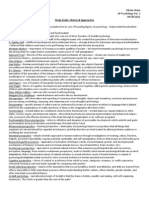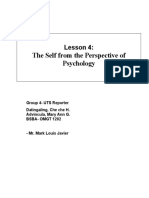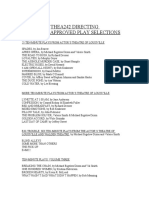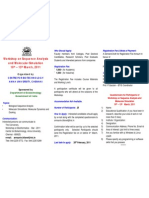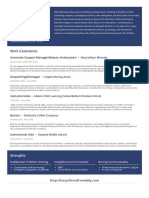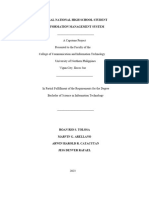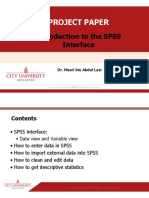0 ratings0% found this document useful (0 votes)
36 viewsSTRUCTURALISM. Wundt Is Best Known For Turning The Study Of: Section 1 Intro
STRUCTURALISM. Wundt Is Best Known For Turning The Study Of: Section 1 Intro
Uploaded by
john FlanneryPsychology is the scientific study of behavior and mental processes. Early theorists like Wundt, James, and Freud established different approaches to understanding the mind. Modern psychology includes fields like behaviorism, cognitive psychology, and humanistic psychology. Personality theories seek to understand how personality develops from childhood experiences, traits, unconscious drives, social relationships, and learning through reinforcement or observation. The major theories include psychoanalytic, trait, social-cognitive, behaviorist, and humanistic approaches.
Copyright:
© All Rights Reserved
Available Formats
Download as DOCX, PDF, TXT or read online from Scribd
STRUCTURALISM. Wundt Is Best Known For Turning The Study Of: Section 1 Intro
STRUCTURALISM. Wundt Is Best Known For Turning The Study Of: Section 1 Intro
Uploaded by
john Flannery0 ratings0% found this document useful (0 votes)
36 views6 pagesPsychology is the scientific study of behavior and mental processes. Early theorists like Wundt, James, and Freud established different approaches to understanding the mind. Modern psychology includes fields like behaviorism, cognitive psychology, and humanistic psychology. Personality theories seek to understand how personality develops from childhood experiences, traits, unconscious drives, social relationships, and learning through reinforcement or observation. The major theories include psychoanalytic, trait, social-cognitive, behaviorist, and humanistic approaches.
Original Description:
hp printer v2938475
Original Title
frick
Copyright
© © All Rights Reserved
Available Formats
DOCX, PDF, TXT or read online from Scribd
Share this document
Did you find this document useful?
Is this content inappropriate?
Psychology is the scientific study of behavior and mental processes. Early theorists like Wundt, James, and Freud established different approaches to understanding the mind. Modern psychology includes fields like behaviorism, cognitive psychology, and humanistic psychology. Personality theories seek to understand how personality develops from childhood experiences, traits, unconscious drives, social relationships, and learning through reinforcement or observation. The major theories include psychoanalytic, trait, social-cognitive, behaviorist, and humanistic approaches.
Copyright:
© All Rights Reserved
Available Formats
Download as DOCX, PDF, TXT or read online from Scribd
Download as docx, pdf, or txt
0 ratings0% found this document useful (0 votes)
36 views6 pagesSTRUCTURALISM. Wundt Is Best Known For Turning The Study Of: Section 1 Intro
STRUCTURALISM. Wundt Is Best Known For Turning The Study Of: Section 1 Intro
Uploaded by
john FlanneryPsychology is the scientific study of behavior and mental processes. Early theorists like Wundt, James, and Freud established different approaches to understanding the mind. Modern psychology includes fields like behaviorism, cognitive psychology, and humanistic psychology. Personality theories seek to understand how personality develops from childhood experiences, traits, unconscious drives, social relationships, and learning through reinforcement or observation. The major theories include psychoanalytic, trait, social-cognitive, behaviorist, and humanistic approaches.
Copyright:
© All Rights Reserved
Available Formats
Download as DOCX, PDF, TXT or read online from Scribd
Download as docx, pdf, or txt
You are on page 1of 6
Final Study Guide Psychology
Unit 1: Introduction to Psychology and Beginnings
Section 1 Intro:
Psychology – the science that deals with the behavior and thinking of humans/organisms
Science – branch of study that is based on systematically conducted research to prove or disprove ideas.
Research is done by collecting data in an organized fashion and by following strict procedures.
Behavior – Activities of people or animals that can be observed directly or measured by special techniques
Thinking – Unobservable activity by which a person or animal recognizes past experiences through the use
of symbols and concepts
Early History:
Introspection – looking within, or examining your own thoughts.
Associationism – theory that our understanding of the world occurs
through ideas associated with similar sensory experiences and
perceptions.
Hippocrates – Abnormal behavior was caused by natural causes, not
evil spirits. He determined that this happened by either a chemical
imbalance in your body or by a head injury. Father of Medicine.
Wilhelm Wundt – set up first lab in Germany to study human behavior
and human consciousness. He mainly used one method, introspection
or looking within, or examining your own thoughts. Because Wundt
studied the structure of human consciousness his approach is known as
STRUCTURALISM. Wundt is best known for turning the study of
behavior into a science.
William James – Harvard professor that developed a new branch of
psychology in the US. He believed that the structure of the mind is less
important than studying how the mid works. Focus on how the mind
functions to help us adapt to our surroundings becomes
FUNCTIONALISM.
Sigmund Freud – Freud was a physician and noticed paralysis of
patients that had no apparent cause. He developed method called
PSYCHOANALYSIS. The idea is human behavior is influenced by
feelings or wishes buried deep in ourselves. People are unaware of
them and many times these thoughts contradict those of which they are
aware. Produces severe inner conflicts in people. Also called Freudian
Slips. UNCONSCIOUS. The process of bringing unconscious feeling
to the surface is called PYSCHOANALYSIS. Freud used hypnosis, free
association, and dream analysis.
Modern Developments:
John Watson – a psychologist in the early 1900s. He believed that the
mind could not be measured and any work using introspection did not
constitute scientific evidence. He thought that observable behavior
should be the main focus of study. Founder of behaviorism. REWARD
Albert Bandura – Bandura believes that behavior is learned mostly
through observation and imitation. Modeling behavior.
B.F. Skinner – Skinner revised and expanded Watson’s theories.
Believes organisms can be controlled via positive and negative
reinforcement.
Eclectic – combined approach
Branches of Psychology:
Structuralism – study of the structure of human consciousness,
introspection
Functionalism - Focus on how the mind functions to help us adapt to
our surroundings
Psychoanalysis - human behavior is influenced by feelings or wishes
buried deep in ourselves.
Behaviorism – study of observable behavior
Cognitive – focuses on how people perceive, store, and interpret
information.
Gestalt – German word for form or shape.
Existential – stresses the importance of individual choice in
determining human behavior. Free will.
Humanistic – the study of how people try to achieve their maximum
potential through health and self-growth. Self-actualization.
Section 2 Experiments:
Hypothesis – tentative assumption, educated statement. States what you
are trying to prove/disprove
Independent/dependent variable – Independent variable is controlled or
manipulated by the experimenter. Dependent variable is the variable
that changes in response to the independent variable.
Placebo Effect – substance or treatment that has no effect apart from a
person’s belief in its affect.
Single Blind Study – participants do not know whether they are in the
experimental or control group
Double Blind Study – participants and researcher do not know who is
in each group.
Theory – a general principle, based on information, to explain what has
been learned. The results.
Correlation (Positive and Negative) – Positive correlation is the
relationship between variables in which variables increase together.
Negative correlation the relationship between variables where one
variable increases and the other decreases. This only describes
relationships. It does not predict the outcome. CORRELATION DOES
NOT EQUAL CAUSATION
Anthropomorphism – attributing human characteristics to animals and
pets
Control group – the group in which the condition is not present, used to
check results against
Experimental group – the group in which the condition being studied is
present
Unit 2: Personality Theories
Section 1: Theories of Personality:
Personality – the patterns of feelings, motives, and behavior that set people apart
from one another.
What are the four important areas where personality is developed? Know each one.
Early Childhood is very important time for the development of personality.
During the first 6 months, behavior becomes individualized as they react to different
stimuli.
Many foundations of personality are laid down early in life. Most of a child’s
early life is spent at, or in, the home.
Birth Order is known as care for the first born that’s more nurturing than
care for the 2nd born, unless the 2nd born is a different gender than the first. A
decrease in motherly attention is often noticeable.
Society consists of a large group of people who share common traits, customs
or ways or behaving. In our society, we learn from religious activities, school, work,
and play with other children.
Section 2: Trait Theories
Trait – aspect of personality that is considered to be reasonably stable. We assume
the person has certain traits depending on how they behave. Traits are also
assumed to be consistent.
Section 3: Psychoanalytic Theory
Super Ego – moral aspects, values and ideas of society learned by individuals, strives
for perfection
Ego – conscious, involves learned ways of behaving, balances the id and superego by
operating on the basis of the reality principle.
Id – the original system of personality, completely unconscious, acts according to the
pleasure principle
Sigmund Freud – believed personality is composed of 3 systems: I, E, SE.
Defense Mechanisms – used by the ego in order to avoid ideas or emotions that may
cause anxiety.
Repression – removing anxiety causing them ideas from the conscious by pushing
them to the unconscious.
Rationalization – use of self-deception to justify unacceptable behaviors or ideas.
Regression – when stress is present, a person returns to behavior that is
characteristic of an earlier stage of development
Projection – dealing with unacceptable impulses by projecting these impulses
outward onto other people.
Carl Jung – came up with Archetypes, divided the unconscious mind into the
personal unconscious and the collective unconscious which affect our personality
without our knowledge. 2 major attitudes, Intro/Extrospection.
Archetypes – ideas and images of the accumulated experiences of all human beings,
basic/primitive concepts
Section 4: Social Psychoanalytic Theory
Erik Erickson – divided personality into 8 stages. A crisis must be solved in each
stage. Personality characteristics are developed with each crisis.
Karen Horney – emphasized the social relationships between young children and
their parents. Actions and personality is formed by how the parents interact or treat
the child
Harry Stack Sullivan – Personality relies on our relationship with other people and
situations. We are all members of a social group. Focuses on 3 processes that occur
in interpersonal relationships: dynamism, personification and cognitive processes.
Alfred Adler – emphasized that people are primarily social creatures and motivated
by a need to overcome feelings of inferiority.
Inferiority Complex – Feelings of inadequacy and insecurity that serve as a central
source of motivation
Erich Fromm – personality is shaped by the interaction between our basic needs
and the opportunity in society for fulfilling them. 5 needs: relatedness,
transcendence, belonging, identity, and frame of reference.
Creative Self – what makes people strive toward complete fulfillment, create goals,
and the means to achieve them
Dynamism – smallest unit that can be studied about an individual, pattern of
behavior that occurs over and over again like a habit
Personification – image people have of themselves or of another person, involves
attitudes, feelings, and ideas, may or may not be correct
Cognitive Processes – consists of ways of thinking, may include symbols, words, or
numbers, enables people to communicate with one another
Section 5: Behavioristic Theory
Reinforcement – Reward behavior to increase the chance of the behavior occurring
again
Know the difference between positive and negative punishment/reinforcement. Be able to come up
with examples
Punishment – any form of unpleasant or painful stimulation after undesirable
performance
Model – person whose behavior is imitated
B.F. Skinner – defines personality in terms of behavior, have to study what
conditions produce specific behaviors. Examine relationship between cause and
effect – can only analyze external events. Reinforcement does create behavior and to
a certain extent so does punishment.
Albert Bandura – Social Cognitive Theory – personality is shaped and learning is
acquired by personal factors, behavior, and environmental factors. He believes that
behavior is learned mostly through observation and imitation and reinforces these
new behaviors. Models help shape our personalities.
Section 6: Humanistic Theory
Self-Actualization – realization of our potentialities as unique human beings, being
responsible, authentic, true to oneself, and be able to grow
Self-concept – system of attitudes that people have towards themselves
Abraham Maslow – explained personality and human behavior in terms of
motivation. People act certain ways because they are motivated by certain needs.
Maslow created a hierarchy of 5 needs.
Carl Rogers – Also believes in self-actualization but states people will form their
personality even if they don’t become self-actualized. The important part of
personality development is self-concept. We behave in ways that support our self-
concept.
Section 7: Psychological Tests
Pigeonholing – categorize someone into a certain type of category
Stereotype – when you expect an individual to have characteristics despite no direct
evidence to support the idea. Applied to an individual on previously formed
judgments. Usually involves races, genders, religions
Over-rating – rating someone higher than you should
Halo Effect – when the presence of a single positive attribute leads you to
unconsciously assume a person has other positive traits
Horn Effect – when the presence of one negative trait leads to further negative
assumptions
Valid – a test needs to measure what it is supposed to.
Reliable – test results need to be similar each time you take that same test.
Unit 3: Psychological Disorders
Section 1:
Psychological Disorders – behavior patterns or mental processes that cause serious personal
suffering or interfere with a person’s ability to cope with every day. 6 general categories of disorders.
Phobias – Strong unreasonable fear of a specific object or situation. (Irrational fear) Person usually
realizes the fear is irrational.
Obsessive-Compulsive Disorder – Constant unpleasant thoughts or images which causes an
overwhelming need to repeat certain acts over and over again. If a pattern is broken it causes
extreme anxiety.
Post-Traumatic Stress Disorder – Often have lasting and frightening thoughts and memories of an
event and tend to be emotionally numb. Events can be war, natural disaster, unexpected death of a
loved one, or other accidents.
Bipolar Disorder – cycle of mood changes from depression to wild elation and back again. Major
Depression – feelings of helplessness, hopelessness, worthlessness, guilt and sadness
Section 2:
Hypochondriasis – person’s unrealistic preoccupation with thoughts that he or she has a serious
illness.
Dissociative Identity Disorder – also known as “multiple personality” and is extremely rare and
controversial. A person has at least 2 different and consistent identities that alternatively control a
person’s behavior. Different people are created inside of one person, and they are usually aware of
each other. Conflict happens by trying to satisfy each “identity.” This disorder is usually brought
about by a traumatic event or abuse as a child.
Section 3:
Schizophrenia – the most serious psychological disorder, causes thought disruption and a decreased
ability to function normally. Loss of contact with reality, hallucinations (usually auditory), delusions,
individuals may believe they are historical figures, famous celebrities, or on secret mission, may
repeat words, or speak in illogical ways. Around 2.4 million people are affected by this in the U.S.
Paranoid Schizophrenia – delusions or frequent auditory hallucinations, all relating to a single theme.
Disorganized Schizophrenia – Incoherent in their thought, speech and disorganized in their behavior.
Also emotionless or show inappropriate emotions. Neglect appearance, hygiene, may lose control of
their bladders/bowels
Section 4:
Personality Disorders – patterns of inflexible traits that disrupt social life/work and may distress the
individual.
Antisocial PD – persistent behavior pattern of disregard for, and violation of the rights of others.
They do not feel remorse.
Borderline PD – instability of mood, chaotic personal relationships, disturbed sense of self.
You might also like
- Letter of Intent For Educational PartnershipDocument2 pagesLetter of Intent For Educational PartnershipTerri Mayangsari Yunus100% (3)
- Miriamsong Piano Turning Kit Guidebook NewestDocument14 pagesMiriamsong Piano Turning Kit Guidebook Newestjohn FlanneryNo ratings yet
- Cbo2002 To Isco-88 To Isco-08 To 2010socDocument776 pagesCbo2002 To Isco-88 To Isco-08 To 2010socrogeriocbaNo ratings yet
- Self Help CBT Cognitive Behavior Therapy Training Course & Toolbox: Cognitive Behavioral Therapy Book for Anger Management, Depression, Social Anxiety, OCD, Sleep Disorders, Addictions, Fears & moreFrom EverandSelf Help CBT Cognitive Behavior Therapy Training Course & Toolbox: Cognitive Behavioral Therapy Book for Anger Management, Depression, Social Anxiety, OCD, Sleep Disorders, Addictions, Fears & moreRating: 3 out of 5 stars3/5 (1)
- Study Plan: Introduction of My BackgroundDocument5 pagesStudy Plan: Introduction of My BackgroundJannice CordeliaNo ratings yet
- Green TaraDocument125 pagesGreen TaraFladrif100% (8)
- Conversion Optimization PDFDocument80 pagesConversion Optimization PDFMarija Veljkovic100% (3)
- Unit 2 Study Guide Terms/Matching/Multiple Choice Section 1: Theories of PersonalityDocument5 pagesUnit 2 Study Guide Terms/Matching/Multiple Choice Section 1: Theories of Personalityjohn FlanneryNo ratings yet
- Nature and Scope of PsychologyDocument3 pagesNature and Scope of PsychologyCarla JoyceNo ratings yet
- Lesson 1 Introduction To PsychologyDocument8 pagesLesson 1 Introduction To PsychologyMel P. ManaloNo ratings yet
- Psychology 1 1 1 1Document80 pagesPsychology 1 1 1 1opudodavid500No ratings yet
- Unit 2 Study Guide Terms/Matching/Multiple Choice Section 1: Theories of PersonalityDocument3 pagesUnit 2 Study Guide Terms/Matching/Multiple Choice Section 1: Theories of Personalityjohn FlanneryNo ratings yet
- General Psychology 023526Document582 pagesGeneral Psychology 023526Solomon MesfinNo ratings yet
- Introduction To PsychologyDocument10 pagesIntroduction To PsychologyLornie SagarioNo ratings yet
- PSYCHOLOGYDocument8 pagesPSYCHOLOGYAbubakkars SiddiqNo ratings yet
- Discovering PsychologyDocument29 pagesDiscovering PsychologyWeezyrasp0% (1)
- Introduction To Psychology Prelims 2Document8 pagesIntroduction To Psychology Prelims 2Kamille Hannah JimenezNo ratings yet
- Cri 177 P1 OralDocument5 pagesCri 177 P1 Oraldaja.apdian.cocNo ratings yet
- INTROPSY Reviewer (Book-Based Only) Chapters 1-2Document12 pagesINTROPSY Reviewer (Book-Based Only) Chapters 1-2RAYNE BERNADETTE BALINASNo ratings yet
- The Science of PsychologyDocument43 pagesThe Science of PsychologyPavitra SatyamNo ratings yet
- General PsychologyDocument65 pagesGeneral PsychologynaolhurgasaNo ratings yet
- Study Guide: History & Approaches: Vikram Akam AP Psychology Per. 2 09/30/2011Document3 pagesStudy Guide: History & Approaches: Vikram Akam AP Psychology Per. 2 09/30/2011Vik6370No ratings yet
- Behaviour and DisciplineDocument5 pagesBehaviour and Disciplinedominikjuras17No ratings yet
- PsychologyDocument5 pagesPsychologyAfrasiab HassanNo ratings yet
- The Methods of Study of PsychologyDocument5 pagesThe Methods of Study of Psychologyمحمد سعد طهNo ratings yet
- Psychology Cherryl Calades - Copy (Autosaved)Document184 pagesPsychology Cherryl Calades - Copy (Autosaved)carlo john balleta100% (1)
- PAPALIA - Chapter 2Document16 pagesPAPALIA - Chapter 2nniceenallaNo ratings yet
- Introduction To Psychology Schools of Thoughts in Psychology. (Week 1)Document6 pagesIntroduction To Psychology Schools of Thoughts in Psychology. (Week 1)jasim buttNo ratings yet
- 527291701-Human-Behavior-VictimologyDocument163 pages527291701-Human-Behavior-VictimologyM E D I O S I T ONo ratings yet
- The Self From The Perspective of Psychology: Lesson 4Document20 pagesThe Self From The Perspective of Psychology: Lesson 4cheche datingaling100% (1)
- Personality: Chapter 11, PSY 121 DTCCDocument63 pagesPersonality: Chapter 11, PSY 121 DTCCjayjindeNo ratings yet
- Chapter One: Essence of Psychology: Learning OutcomesDocument40 pagesChapter One: Essence of Psychology: Learning OutcomesNigussie BerhanuNo ratings yet
- Business PsychologyDocument7 pagesBusiness PsychologyRaz MahariNo ratings yet
- Chapter 1 Psych NotesDocument13 pagesChapter 1 Psych Notesjovilla100% (2)
- Notes Educational PsychologyDocument19 pagesNotes Educational Psychologyjunaid.get.orgNo ratings yet
- Psychoanalytic Theory by Sigmund FreudDocument7 pagesPsychoanalytic Theory by Sigmund FreudEloisa Bretaña100% (1)
- M1 - Nature of Psychology - 1583047440Document5 pagesM1 - Nature of Psychology - 1583047440yanyansimon100No ratings yet
- Introduction To PsychologyDocument34 pagesIntroduction To PsychologyRazi BaigNo ratings yet
- What Is Psychology Class 11 Cbse NotesDocument8 pagesWhat Is Psychology Class 11 Cbse Notessome weebNo ratings yet
- General Psychology Unit-OneDocument44 pagesGeneral Psychology Unit-OnemurtiketkebNo ratings yet
- General Psychology Note in 2021 G.C Imnd CollegeDocument10 pagesGeneral Psychology Note in 2021 G.C Imnd Collegekbk3mohNo ratings yet
- Study Guide 1Document17 pagesStudy Guide 1Kimberly RenaeNo ratings yet
- class notes for introduction to psyschologyDocument4 pagesclass notes for introduction to psyschologyshanzahNo ratings yet
- Psychology2 PDFDocument7 pagesPsychology2 PDFRahat Fardin RiyadNo ratings yet
- Introduction To PsychologyDocument21 pagesIntroduction To PsychologyRohanMittalNo ratings yet
- Module 1 Intro To PsychologyDocument9 pagesModule 1 Intro To PsychologyGinelQuenna De VillaNo ratings yet
- Schools of Thoughts in PsychologyDocument5 pagesSchools of Thoughts in PsychologyPerla MartinezNo ratings yet
- What Is PsychologyDocument4 pagesWhat Is PsychologyKhim Wanden AvanceNo ratings yet
- Humanbehaviorpart 1Document10 pagesHumanbehaviorpart 1Faith CastilloNo ratings yet
- Week 1 Introduction Psychology and PedagogyDocument3 pagesWeek 1 Introduction Psychology and Pedagogylara.van.kemenadeNo ratings yet
- The Science of PsychologyDocument5 pagesThe Science of PsychologyWallen LagradaNo ratings yet
- Nursing Psychology Unit 1Document16 pagesNursing Psychology Unit 1Ojashwee Uprety TutuNo ratings yet
- Only $1/monthDocument8 pagesOnly $1/monthWill BendijoNo ratings yet
- Social PsychologyDocument12 pagesSocial Psychologywarda butt0% (1)
- Psychology Test Notes 1-3 - 6Document20 pagesPsychology Test Notes 1-3 - 6LaraibNo ratings yet
- 1 Human BehaviorDocument11 pages1 Human Behaviorjcoolj575No ratings yet
- Crash Course Psychology #3Document25 pagesCrash Course Psychology #3Rocelle AlcaparazNo ratings yet
- Psychological View of The Self PDFDocument9 pagesPsychological View of The Self PDFKimberly Pascua ArizNo ratings yet
- 1-Social Psych (1) .......Document46 pages1-Social Psych (1) .......areeshakashif21No ratings yet
- The Self From The Various PerspectiveDocument32 pagesThe Self From The Various PerspectiveAshierah MontasNo ratings yet
- Reviewer For General PsychologyDocument14 pagesReviewer For General PsychologyAnna Marie MianoNo ratings yet
- Introduction To PsychologyDocument16 pagesIntroduction To PsychologyAbdulqadir AbdallaNo ratings yet
- General Psychology Chapter 1Document8 pagesGeneral Psychology Chapter 1Tola GemedaNo ratings yet
- General psychology Chapter 1Document8 pagesGeneral psychology Chapter 1Yemariyam TadeleNo ratings yet
- General Psychology Unit 1-4 NEW-2-2-1Document107 pagesGeneral Psychology Unit 1-4 NEW-2-2-1alebelkinde81No ratings yet
- Compare & Contrast The Behaviourist and Psychodynamic Approaches in Psychology. Paying Particular Attention To Conceptual & Methodological DifferencesDocument4 pagesCompare & Contrast The Behaviourist and Psychodynamic Approaches in Psychology. Paying Particular Attention To Conceptual & Methodological DifferencesKate Orange0% (1)
- Agamemnon WorksheetDocument1 pageAgamemnon Worksheetjohn FlanneryNo ratings yet
- Backwards and Forwards Discussion QuestionsDocument2 pagesBackwards and Forwards Discussion Questionsjohn FlanneryNo ratings yet
- Agamemnon WorksheetDocument2 pagesAgamemnon Worksheetjohn FlanneryNo ratings yet
- 01700820210211111324Document1 page01700820210211111324john FlanneryNo ratings yet
- Unit 3: Psychological Disorders Study Guide Section 1Document3 pagesUnit 3: Psychological Disorders Study Guide Section 1john FlanneryNo ratings yet
- 2021 Pre-Approved Play ListDocument3 pages2021 Pre-Approved Play Listjohn FlanneryNo ratings yet
- Untitled PDFDocument3 pagesUntitled PDFjohn FlanneryNo ratings yet
- (Untitled) PDFDocument19 pages(Untitled) PDFjohn FlanneryNo ratings yet
- Dante 02 Purgatorio PDFDocument250 pagesDante 02 Purgatorio PDFjohn FlanneryNo ratings yet
- That White Elephant Mixtape That You Regret Getting: From John FlanneryDocument8 pagesThat White Elephant Mixtape That You Regret Getting: From John Flanneryjohn FlanneryNo ratings yet
- BPA Homecoming Flower To: - FromDocument1 pageBPA Homecoming Flower To: - Fromjohn FlanneryNo ratings yet
- Metric System: Prefix Symbol Multiplication Factor Scientific NotationDocument2 pagesMetric System: Prefix Symbol Multiplication Factor Scientific Notationjohn FlanneryNo ratings yet
- Foundation Course in ImplantologyDocument2 pagesFoundation Course in ImplantologyBrijesh Kumar SinghNo ratings yet
- Speed Control Method of MotorDocument13 pagesSpeed Control Method of MotorChaitanya PatilNo ratings yet
- English Language: University of Cambridge International Examinations General Certificate of Education Ordinary LevelDocument4 pagesEnglish Language: University of Cambridge International Examinations General Certificate of Education Ordinary Levelmstudy123456No ratings yet
- Exam Principiante 3 Unit 6 General TestDocument6 pagesExam Principiante 3 Unit 6 General TestMA RE SurfNo ratings yet
- Letterofrec SaraDocument2 pagesLetterofrec Saraapi-412018779No ratings yet
- The Psycholinguistic Reality of CollocationDocument26 pagesThe Psycholinguistic Reality of CollocationCennet EkiciNo ratings yet
- Importance of Entrepreneurial LeadershipDocument14 pagesImportance of Entrepreneurial Leadershipreki.fernando.au100% (1)
- The Lessons of LeadershipDocument29 pagesThe Lessons of LeadershipAaron Mearns100% (1)
- SSCMR NC BrochureDocument4 pagesSSCMR NC Brochureziyan skNo ratings yet
- Epze 7 B NXSaDocument10 pagesEpze 7 B NXSajuandaniel.garcia.veigaNo ratings yet
- Psychological Problems and Coping Strategies Adopted by Post Menopausal WomenDocument9 pagesPsychological Problems and Coping Strategies Adopted by Post Menopausal WomenJannica Mae D SacristiaNo ratings yet
- CVTemplate K.Fedel Timovski PDFDocument3 pagesCVTemplate K.Fedel Timovski PDFKRISTINANo ratings yet
- WorkshopDocument1 pageWorkshop9677577517No ratings yet
- Club 21 Scholarship Application ChecklistDocument1 pageClub 21 Scholarship Application ChecklistKoh See Hui RoxanneNo ratings yet
- Tugas Modul 1 - Pak DediDocument11 pagesTugas Modul 1 - Pak DediMuhammad IrfanNo ratings yet
- My Current ResumeDocument1 pageMy Current ResumeMaximum Safetech Solution MSTSNo ratings yet
- Answer Sheet UpdatedDocument1 pageAnswer Sheet UpdatedJOHN RUSTY FIGURACIONNo ratings yet
- Pbla R Classified Ads Js CLB 5Document9 pagesPbla R Classified Ads Js CLB 5kietb2308No ratings yet
- Bachelor of Technology Electronics and Communication EngineeringDocument14 pagesBachelor of Technology Electronics and Communication EngineeringyanonNo ratings yet
- Chapter 3 - 4Document22 pagesChapter 3 - 4riselle alfilerNo ratings yet
- Karyn Linnell Teaching ResumeDocument1 pageKaryn Linnell Teaching Resumeapi-534627931No ratings yet
- EmpowermentDocument17 pagesEmpowermentYogesh TomarNo ratings yet
- Magsingal National High School Student Last CheckingDocument71 pagesMagsingal National High School Student Last CheckingJan Allen RialubinNo ratings yet
- Resume Sami RahmanDocument2 pagesResume Sami Rahmanmohammad hussainNo ratings yet
- Spss Beginners 0Document12 pagesSpss Beginners 0Raguwaran SamayyahNo ratings yet





















